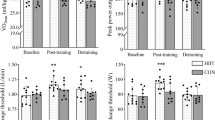Abstract
We examined changes in muscle buffer capacity (βmin vitro), \( \ifmmode\expandafter\dot\else\expandafter\.\fi{V}{\text{O}}_{{{\text{2peak}}}} \) and the lactate threshold (LT) after 5 weeks of high-intensity interval training (INT) above the LT or moderate-intensity continuous training (CON) just below the LT. Prior to and immediately after training, 16 female subjects performed a graded exercise test to determine \( \ifmmode\expandafter\dot\else\expandafter\.\fi{V}{\text{O}}_{{{\text{2peak}}}} \) and the LT, followed 2 days later by a resting muscle biopsy from the vastus lateralis muscle to determine βmin vitro. Following baseline testing, the subjects were randomly placed into the INT (n=8) or CON training group (n=8). Subjects then performed 5 weeks of cycle training (3 days per week), performing either high-intensity INT (6–10×2 min at 120–140% LT with 1 min rest) or moderate-intensity CON (80–95% LT) training. Total training volume was matched between the two groups. After the training period, both groups had significant improvements in \( \ifmmode\expandafter\dot\else\expandafter\.\fi{V}{\text{O}}_{{{\text{2peak}}}} \) (12–14%; P<0.05) and the LT (7–10%; P<0.05), with no significant differences between groups. The INT group, however, had significantly greater improvements in βmin vitro (25%; 123±5–153±7 μmol H+·g muscle dm−1·pH−1; P<0.05) than the CON group (2%; 130±12–133±7 μmol H+·g muscle dm−1·pH−1, P>0.05). Our results show that when matched for training volume, high-intensity interval training above the LT results in similar improvements in \( \ifmmode\expandafter\dot\else\expandafter\.\fi{V}{\text{O}}_{{{\text{2peak}}}} \) and the LT, but greater improvements in βmin vitro than moderate-intensity continuous training below the LT. This suggests that training intensity is an important determinant of changes to βmin vitro.



Similar content being viewed by others
References
Ahlborg G, Hagenfeldt L, Wahren J (1975) Substrate utilization by the inactive leg during one-leg or arm exercise. J Appl Physiol 39:718–723
Arthur PG, Hogan MC, Bebout DE, Wagner PD, Hochachka PW (1992) Modeling the effects of hypoxia on ATP turnover in exercising muscle. J Appl Physiol 73:737–742
Baldwin J, Snow RJ, Febbraio MA (2000) Effect of training status and relative exercise intensity on physiological responses in men. Med Sci Sports Exerc 32:1648–1654
Bell GJ, Wenger HA (1988) The effect of one-legged sprint training on intramuscular pH and non-bicarbonate buffering capacity. Eur J Appl Physiol 58:158–164
Bishop D, Jenkins DG, Mackinnon LT (1998) The relationship between plasma lactate parameters, Wpeak and 1-h cycling performance in women. Med Sci Sports Exerc 30:1270–1275
Carter H, Jones AM, Barstow TJ, Burnley M, Willimams C, Doust JH (2000) Effect of endurance training on oxygen uptake kinetics during treadmill running. J Appl Physiol 89:1744–1752
Chwalbinska-Moneta J, Robergs R, Costill DL, Fink WJ (1989) Threshold for muscle lactate accumulation during progressive exercise. J Appl Physiol 66:2710–2716
Costill DL, Verstappen F, Kuipers H, Janssen E, Fink W (1984) Acid–base balance during repeated bouts of exercise: influence of HCO3. Int J Sports Med 5:228–231
Cunningham DA, McCrimmon D, Vlach LF (1979) Cardiovascular response to interval and continuous training in women. Eur J Appl Physiol 41:187–197
Edge J, Bishop D, Goodman C (2003) Little effect of induced metabolic alkalosis on adaptations in muscle buffer capacity. In: 8th annual congress European college of sport science, p 28
Edge J, Bishop D, Hill-Haas S, Goodman C, Dawson B (2005) Comparison of muscle buffer capacity and repeated-sprint ability of untrained, endurance-trained and team-sport athletes. Eur J Appl Physiol (in press)
Eversten F, Medbo JI, Bonen A (2001) Effect of training intensity on muscle lactate transporters and lactate threshold of cross-country skiers. Acta Physiol Scand 173:195–205
Fabiato A, Fabiato F (1978) Effects of pH on the myofilaments and the sarcoplasmic reticulum of skinned cells from cardiac and skeletal muscles. J Physiol 276:233–255
Favero TG, Zable AC, Bowman M, Thompson A, Abramson JJ (1995) Metabolic end products inhibit sarcoplasmic reticulum Ca2+ release and [H]ryanodine binding. J Appl Physiol 78:1665–1672
Gore CJ, Hahn AG, Aughey RJ, Martin DT, Ashenden MJ, Clark SA, Garnham AP, Roberts AD, Slater GJ, McKenna MJ (2001) Live high:train low increases muscle buffer capacity and submaximal cycling efficiency. Acta Physiol Scand 173:275–286
Gorostiaga EM, Walter CB, Foster C, Hickson RC (1991) Uniqueness of interval and continuous training at the same maintained exercise intensity. Eur J Appl Physiol 63:101–107
Harmer AR, McKenna MJ, Sutton JR, Snow RJ, Ruell PA, Booth J, Thompson MW, Mackay NA, Stathis CG, Crameri RM, Carey MF, Eager DM (2000) Skeletal muscle metabolic and ionic adaptations during intense exercise following sprint training in humans. J Appl Physiol 89:1793–1803
Mannion AF, Jakeman PM, Dunnett M, Harris RC, Willan PL (1992) Carnosine and anserine concentrations in the quadriceps femoris muscle of healthy humans. Eur J Appl Physiol 64:47–50
Mannion AF, Jakeman PM, Willan PLT (1993) Determination of human skeletal muscle buffer value by homogenate technique: methods of measurement. J Appl Physiol 75:1412–1418
Mannion AF, Jakeman PM, Willan PLT (1994) Effects of isokinetic training of the knee extensors on high-intensity exercise performance and skeletal muscle buffering. Eur J Appl Physiol 68:356–361
Mannion AF, Jakeman PM, Willan PLT (1995) Skeletal muscle buffer value, fibre type distribution and high intensity exercise performance in man. Exp Physiol 80:89–101
Nevill ME, Boobis LS, Brooks S, Williams C (1989) Effect of training on muscle metabolism during treadmill sprinting. J Appl Physiol 67:2376–2382
Parkhouse WS, McKenzie DC (1984) Possible contribution of skeletal muscle buffers to enhanced anaerobic performance; a brief review. Med Sci Sports Exerc 16:328–338
Parkhouse WS, McKenzie DC, Hochachka PW, Ovalle WK (1985) Buffering capacity of deproteinized human vastus lateralis muscle. J Appl Physiol 58:14–17
Pedersen TH, Nielsen OB, Lamb GD, Stephenson DG (2004) Intracellular acidosis enhances the excitability of working muscle. Science 305:1144–1147
Phillips SM, Green HJ, Tarnopolsky MA, Heigenhauser GJ, Grant SM (1996) Progressive effect of endurance training on metabolic adaptations in working skeletal muscle. Am J Physiol 270:E265–E272
Pilegaard H, Domino K, Noland T, Juel C, Hellsten Y, Halestrap AP, Bangsbo J (1999) Effect of high-intensity exercise training on lactate/hydrogen ion transport capacity in human skeletal muscle. Am J Physiol 276:E255–E261
Poole DC, Gaesser GA (1985) Response of ventilatory and lactate thresholds to continuous and interval training. J Appl Physiol 58:1115–1121
Sahlin K, Henriksson J (1984) Buffer capacity and lactate accumulation in skeletal muscle of trained and untrained men. Acta Physiol Scand 122:331–339
Sahlin K, Harris RC, Nylind B, Hultman E (1976) Lactate content and pH in muscle samples obtained after dynamic exercise. Plugers Arch 367:143–149
Sharp RL, Costill DL, Fink WJ, King DS (1986) Effects of eights weeks of bicycle ergometer sprint training on human muscle buffer capacity. Int J Sports Med 7:13–17
Spriet LL, Lindinger MI, McKelvie RS, Heigenhauser GJF, Jones NL (1989) Muscle glycogenolysis and H+ concentration during maximal intermittent cycling. J Appl Physiol 66:8–13
Stephens TJ, McKenna MJ, Canny BJ, Snow RJ, McConell GK (2002) Effect of sodium bicarbonate on muscle metabolism during intense endurance cycling. Med Sci Sports Exerc 34:614–621
Susuki Y, Ito O, Takahashi H, Takamatsu K (2004) The effect of sprint training on skeletal muscle carnosine in humans. Int J Sport Health Sci 2:105–110
Swank A, Robertson RJ (1989) Effect of induced alkalosis on perception of exertion during intermittent exercise. J Appl Physiol 67:1862–1867
Tabata I, Nishimura K, Kouzaki M, Hirai Y, Ogita F, Miyachi M, Yamamoto K (1996) Effects of moderate-intensity endurance and high-intensity intermittent training on anaerobic capacity and VO2max. Med Sci Sports Exerc 28:1327–1330
Troup JP, Metzger JM, Fitts RH (1986) Effect of high-intensity exercise training on functional capacity of limb skeletal muscle. J Appl Physiol 60:1743–1751
Weston AR, Wilson GR, Noakes TD, Myburgh KH (1996) Skeletal muscle buffering capacity is higher in the superficial vastus than in the soleus of spontaneously running rats. Acta Physiol Scand 157:211–216
Weston AR, Myburgh KH, Lindsay FH, Dennis SC, Noakes TD, Hawley JA (1997) Skeletal muscle buffering capacity and endurance performance after high-intensity interval training by well-trained cyclists. Eur J Appl Physiol 75:7–13
Author information
Authors and Affiliations
Corresponding author
Rights and permissions
About this article
Cite this article
Edge, J., Bishop, D. & Goodman, C. The effects of training intensity on muscle buffer capacity in females. Eur J Appl Physiol 96, 97–105 (2006). https://doi.org/10.1007/s00421-005-0068-6
Accepted:
Published:
Issue Date:
DOI: https://doi.org/10.1007/s00421-005-0068-6




